
Regional Variations in Pricing
Pricing for Emergency Roadside Assistance can vary significantly across different regions in the United States. Urban areas often exhibit higher rates due to increased demand and overhead costs. In these locations, providers may charge more for services such as towing or tire changes, influenced by factors like traffic, higher fuel costs, and a greater number of incidents requiring assistance. Conversely, rural areas typically experience lower average costs. Providers in these regions may have fewer operational expenses, although service availability can be less frequent, potentially leading to longer wait times.
Additionally, economic conditions and local competition play a vital role in shaping pricing structures. Regions with a high concentration of service providers may offer more competitive rates as companies vie for customers. In contrast, areas with fewer options may not have the same pricing pressures, allowing providers to maintain higher rates. The demand for Emergency Roadside Assistance can also fluctuate due to local cultural attitudes toward car maintenance and driving habits, impacting how often these services are utilized.
Urban vs. Rural Rates
Urban areas often experience higher costs for Emergency Roadside Assistance due to several factors. The density of vehicles on the road leads to a greater demand for services, which can drive up prices. Additionally, infrastructure costs in cities, such as parking and labor, are typically higher, contributing to elevated rates for assistance.
In contrast, rural regions generally see lower costs associated with Emergency Roadside Assistance. The fewer vehicles on the road mean reduced demand for services, which can help keep prices down. However, the geographical spread can sometimes lead to longer response times, as service providers may cover larger areas with fewer resources. This dynamic can affect how pricing is structured, taking into account the availability and speed of service.
Seasonal Cost Fluctuations
Seasonal changes can significantly affect the pricing of Emergency Roadside Assistance services. During the winter months, particularly in regions prone to snow and ice, the demand for assistance increases. This surge can lead to higher service fees as providers adjust their pricing to accommodate the influx of customers. Similarly, summer road trips often result in more motorists requiring assistance, especially during holiday weekends when travel is at its peak.
During these high-demand seasons, some companies may offer promotional pricing or special packages to attract more clients. Alongside these promotions, factors such as the availability of service providers and local competition can influence costs. Consumers need to stay informed about these seasonal fluctuations to make budget-friendly choices for their Emergency Roadside Assistance needs.
How Weather Impacts Pricing
Weather conditions can significantly influence the pricing of emergency roadside assistance services. During severe weather events such as snowstorms or hurricanes, demand for these services often spikes. This increased demand can lead to higher rates, as service providers may need to charge more to manage the surge in requests and the additional risks involved in navigating dangerous road conditions.
Moreover, certain times of the year experience predictable shifts in weather patterns, which can also affect pricing. For instance, seasonal changes that bring extreme cold can lead to a rise in vehicle breakdowns, prompting service providers to adjust their rates accordingly. During these peak times, consumers might find that costs for emergency roadside assistance fluctuate more than during milder months, reflecting both the increased frequency of service calls and the associated operational challenges faced by providers.
Discounts and Promotions
Many companies offering Emergency Roadside Assistance provide discounts and promotions to attract new customers and retain existing ones. These offers can include seasonal discounts, referral bonuses, and introductory rates for first-time users. It is common for roadside assistance programs to have promotional events during the summer travel season or around holiday periods when demand for these services rises.
Membership in certain organizations or clubs may also yield significant savings. For instance, automobile associations often bundle Emergency Roadside Assistance with other benefits at a reduced rate. Additionally, companies may offer loyalty programs that reward customers for continued service, enabling them to access further discounts after recurring use of their services.
Membership Benefits
Many companies offer membership options that provide significant savings and added perks for roadside assistance services. By paying an annual fee, members often gain access to services like towing, tire changes, fuel delivery, and battery jumps at reduced rates. These memberships can be especially beneficial for individuals who frequently travel or rely on their vehicles for daily commutes. The cost of membership typically outweighs the amount paid for individual services, making it an economical choice for regular users.
Additionally, members can enjoy exclusive discounts on related services and products, such as vehicle maintenance or rental cars. Many organizations that provide Emergency Roadside Assistance also offer bundled plans that include travel insurance or discounts on hotel stays while stranded. These benefits not only enhance the value of the membership but also provide peace of mind when faced with unexpected vehicle issues.
FAQS
What is the typical cost of roadside assistance services?
The typical cost of roadside assistance services can range from $50 to $150 per incident, depending on the provider and the specific services required.
Are there regional differences in the cost of roadside assistance?
Yes, regional variations in pricing can occur, with urban areas generally charging higher rates than rural locations due to differences in demand, operating costs, and service availability.
How do seasonal changes affect the price of roadside assistance?
Seasonal cost fluctuations can impact pricing, as demand often increases during certain times of the year, such as winter for snow-related incidents, potentially leading to higher service fees.
Do weather conditions influence the cost of roadside assistance?
Yes, adverse weather conditions can lead to increased demand for roadside assistance, which may result in higher prices during storms or extreme weather events.
Are there discounts or promotions available for roadside assistance services?
Many providers offer discounts and promotions, particularly for members of auto clubs or those who purchase annual plans, which can help reduce the overall cost of roadside assistance.
